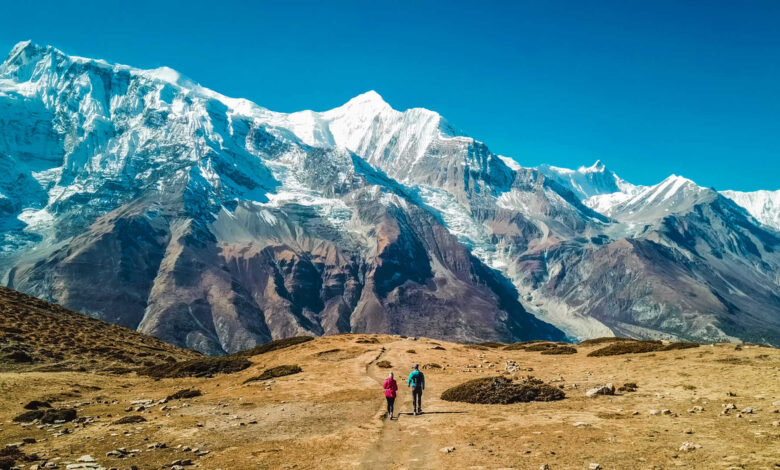Annapurna Base Camp Trekking Your Ultimate Guide to a Sherpa-led Expedition

Table of Contents
Annapurna Base Camp (ABC) Trek is one of the most popular and rewarding trekking experiences in Nepal. This trek, located in the heart of the Annapurna Sanctuary, takes trekkers through verdant greenery, traditional villages, and some of the highest peaks in the world. What really makes this trek so special is the chance to do it alongside Sherpa guides, whose expertise, know-how, and support turn the adventure into an experience to remember. They will help trekkers not just get to the summit, but also guide them through the rigors of high-altitude trekking.
Annapurna base camp trek goes through from rice terraces and sub-tropical jungle to alpine meadows and snow-covered peaks. Each step higher revealing the majestic mountains around you, like Annapurna I, Machapuchare (commonly known as Fish Tail), Dhaulagiri. However, the tough terrains must be traversed and the increasing altitudes must be acclimatized to. This is where Sherpas play a vital role in making sure the expedition is successful. They live in the Himalayas, where they have an unparalleled knowledge of the terrain and weather, as well as cultural practices of various groups. They help trekkers navigate through some tough paths and tricky weather.
Helping with acclimatization is one of the most important jobs of the Sherpas. The risk of altitude sickness increases as trekkers get up high, and it is crucial to ascend slowly to allow the body to acclimatize. Your Sherpas will be meticulous in teaching you about the right practices to properly acclimatize, taking rest days and making slow progress. They also check in on you and are trained to respond to any medical emergencies, so your safety is always the number one priority.
Trekking with Sherpas is also a unique cultural experience. When you walk through Sherpa villages, your guide will talk to you about their traditions, religion and lifestyle. These encounters not only enhance your perspective of the region but also elevate the entire trek. Whether it’s visiting a local monastery, sampling traditional food or sharing in a demonstration of Sherpa hospitality, such experiences are a window on the culture that adds another dimension to the journey.
Your Sherpa guides handle the logistics of the trek: accommodation, meals, and equipment. Trekkers stay in simple but cozy teahouses along the way. Meals are usually traditional Nepali fare to fuel up for long days of trekking. Your Sherpa guides will also assist with the organization of your equipment and make sure everything runs smoothly along the trek allowing you to focus on the adventure and sights around!
The Short Annapurna Base Camp trek with Sherpas is ultimately not just a physical hike, but an experience that immerses anyone in nature at one of the most beautiful mountains in the entire world. The guidance of your Sherpa, with their expertise, warmth, and commitment, makes all the difference: Ensuring that you not only reach your destination, but that you do so in a way that feels empowering, safe, and culturally immersive. You will face your own endurance challenges but be equally rewarded with deeper self teaching, growth and experiences to last a lifetime.
Annapurna Base Camp Trek Overview
The Annapurna Base Camp (ABC) Trek is an endearing and revealing adventure that takes trekkers into of the heart of natural beauty of the Annapurna region of Nepal. The trek is one of Nepal’s most popular hiking routes, known for stunning views of towering peaks, lush valleys, and traditional Gurung villages. The trek to ABC commences with a brief drive from Pokhara to Nayapul. The trail is a mix of subtropical forests, terraced fields, and high alpine meadows. The main attraction of the journey is hiking to Annapurna Base Camp at an altitude of 4,130 meters (13,550 feet), where trekkers are embraced by a 360-degree view of the Annapurna Massif, including Annapurna I, Machapuchare (Fishtail), and Dhaulagiri. The ABC Trek is a great adventure for trekkers of all abilities, and with a little preparation it provides a mixture of physical challenge, cultural experience and natural beauty.
Why Go On a Sherpa-Led Expedition
Reasons why you should go for Annapurna Base Camp Trek with Sherpa-led expedition. Sherpas (or Sherpa) refers to people in the Himalayas, who are known for their strength, endurance and knowledge of high-altitude trekking. They help you navigate the terrain, acclimatise correctly and manage issues if they arise and are incredibly valuable. They also offer cultural insights, sharing their customs, history, and the tales of families whose ancestors have led Himalayan expeditions for generations. The reassurance of having experienced guides by their side at every turn allows trekkers the freedom to fully enjoy the adventure knowing they are in safe hands.
Best Time To Go Trekking to Annapurna Base Camp
The most appropriate time to do the Annapurna Base Camp Trek is the pre-monsoon (spring) season, which is generally between March-May, and the post-monsoon (autumn) season, between September- November. The weather is stable during these months with clear skies providing the best visibility of the glorious mountains and landscapes. In particular, in spring, the rhododendron forests are blooming, and the journey is presented in various colors. Autumn, in contrast, is cooler and provides clear skies and excellent trekking conditions. While winter (December – February) can provide fewer crowds, cold temperatures and potential for snow complicate the trek. The few months of the monsoon season (June to Aug) should be avoided too, as torrential downpours lead to a higher risk of landslides and slippery trekking conditions.
Gear and Fitness: Getting Ready for the Trek
Physical fitness and proper gear are vital dedicated for the Annapurna Base Camp Trek. Since the trek reaches large elevation climbs of over 4,000 meters (and 13,000 feet), trekkers have to be physically conditioned for uphill climbs as well as long walking days. Cardiovascular fitness, strength training and endurance are key, and but regular hiking or backpacking can help condition the body. Gear consists mainly of more robust hiking boots; layered clothes to cope with different temperatures; a sleeping bag; trekking poles; and a backpack. Clothing for rain and snow: Waterproof clothing is essential even more in cases of rain and snow. A quality down jacket, headlamp, water bags and first-aid kit are also on the suggested list. These personal items also need to be packed: sunscreen, sunglasses, and a camera. Des: Well acclimatization, hydration, and awareness of the potential for altitude illness is crucial to a safe and enjoyable trek.
Highlights of the Annapurna Base Camp Route
The Annapurna Base Camp Trek starts in the beautiful city of Pokhara; trekkers drive from there to Nayapul, and hike to Tikhedhunga or Ulleri. The trail gradually climbs through stunning rhododendron forests, terraced fields, and nice settlements like Ghorepani and Tadapani. After walking through the peaceful villages, hikers head toward the sanctuary area, where they first get a taste of the stunning mountainscape. The last part of the trek leads you to Annapurna Base Camp, which lies at the base of the Annapurna Massif. Once you arrive at Machapuchare Base Camp (MBC), this is also an excellent place to absorb sights of the neighbouring peaks before continuing to ABC. This is due not only to the continued natural beauty along the trek but the character of the area as well, with a particular highlight being the local teahouses where meals of traditional Nepali fare can be served. In general, the whole hike is around 7-10 days, as trekkers need to adapt to the elevation.
Detailed Itinerary of The Trek Day-to-Day
The Annapurna Base Camp trek Cost takes approximately 7 to 10 days depending on pace and itinerary. The trek starts here from Pokhara, which trekkers drive to Nayapul and begin the trek. The first day the trail takes you past terraced fields and small villages and leads to Tikhedhunga or Ulleri. Day two brings you to Ghorepani, a popular sunrise spot with spectacular views of the Annapurna and Dhaulagiri ranges. From Ghorepani, trekkers make their way up to Tadapani as they pass through dense rhododendrons forests and take in incredible mountain views. The next day to reach Annapurna Sanctuary, a remarkable place with a perfect view of Annapurna range. On day five, trekkers reach the base camp, where they are greeted by sweeping vistas of the surrounding peaks. The return follows the path established to Pokhara, allowing trekkers a last opportunity to admire the area’s beauty and tranquility.
Acclimatization and altitude management
Acclimatization is a major part of trekking to Annapurna Base Camp, since the trek exceeds 4,000-meter (13,000-foot) altitudes. Trekkers need to give their bodies time to acclimatize to the thinner air to reduce the risk of altitude sickness. You do this through taking regular rest days — for example, by spending a couple of nights in Ghorepani or Tadapani to help your body acclimatize before climbing higher. A slow & steady descent or other words for gradual, no elevation gained quickly. Staying hydrated, eating well, and engaging in light physical activity all facilitate the acclimatization process. Because they are so familiar with high-altitude trekking, Sherpas frequently help guide trekkers over these challenges, watching over them in terms of their health and providing recommendations for the best acclimatization.
Your Trekking Journey: What Sherpas Can Do For You
The Annapurna Base Camp Trek is so vital because of the role of the Sherpas in the areas of guiding, logistics, and safety. These hardy mountaineers hail from the Himalayas and know their way around this type of terrain, especially at altitudes. Sherpas not only carry heavy loads, set up camps, and help trekkers stay on the right track. They also help with acclimatization, manage trekking pace, and are always there to lend a bit of emotional and psychological support. Their passion for the mountains is matched only by their warm nature, and combined, their expertise and heart make them the perfect trekking companions on your Annapurna Base Camp journey.
Actions in Place to Ensure Safety and Security
At the high altitudes so define the Himalayas, the risks of trekking include altitude sickness, severe weather conditions and difficult terrain. Therefore, ensuring a successful journey is closely linked to health and safety measures as well as emergency protocols. Guides (many are Sherpas) are trained to identify altitude sickness symptom and advise on treatments that include descending if condition warrants. In the event of health emergencies, Sherpas are trained in emergency treatment, and can help arrange your helicopter evacuation or other transportation if necessary. They are also outfitted with first aid kits and emergency communication devices, which allow for help to be called in as needed. It is strongly advised to purchase trekking insurance with emergency coverage before the trek.
The Sherpas and local communities know how important culture is in better understanding life in the mountains.
The Annapurna trek provides not only great mountain scenery but an introduction to local culture as well. With their long-running culture and strong connection to the land, Sherpas give impenetrable access to the culture, traditions, and spirituality of the area. Along the way, such as passing through villages like Ghorepani, Tadapani and Chomrong, you will have the chance to meet members of the local Gurung and Magar communities. It is here that trekkers are welcomed into traditional tea houses with local hospitality. Sherpas still share stories of their ancestors, and the meaning of the mountains in their culture, which helps trekkers understand what the people of the Himalayas feel about their mountains on a spiritual level. Through these cultural exchanges, trekkers not only learn but also create lifelong bonds with those who reside in the Annapurna region.
Trekking with those who share the same emotions, accommodation, and food
The Annapurna Base Camp trek accommodation ranges from teahouses (local lodges) to hotels. These teahouses dot the trail, where you can relax, mingle and have meals. Rooms are usually spartan, with twin beds, blankets and shared baths. Hot showers, where available, may be subject to a fee. Meals at these teahouses are your basic staple foods: dal bhat (lentil soup with rice), momo (dumplings), noodle soupなどなど。 So they give you the necessary energy to carry on for the long trekking days ahead. as they guide trekkers, ensuring that they are well-fed and properly rested, choosing accommodations that will be best for acclimatization, and keeping them warm in cold, high-altitude weather. Vegetarian and nonvegetarian meals are commonly included, as are fresh fruits and snacks served during breaks along the trail.
Scenic Highlights and Natural Wonders
Annapurna Base Camp trek is one of the most mesmerizing trekking vacations in the world. The journey leads trekkers through verdant forests, terraced fields and alpine meadows, punctuated by sweeping vistas of the Annapurna range, Machapuchare (Fishtail) and other lofty summits. One of the best parts of this trek is to see the beautiful sunrise from Poon Hill, that lights the first rays of’ the sun on the ice-covered mountains. The scenery changes as trekkers near the base camp, which becomes a dramatic, high-altitude haven encircled by massive cliffs and glaciers. With stunning mountain scenery, tranquil woods, and breathtaking waterfalls, the sights alongthe trek are never-ending.
Overcoming Trekking Hurdles through Sherpa Help
There are challenges in trekking to Annapurna Base Camp. The trail is steep and rocky and difficult, and conditions vary greatly with elevation. Sherpas are critical in guiding trekkers through these challenges. They intimately know the trail so can guide trekkers to navigate the tougher sections which can keep a team moving at a steady pace and also guarantee that everyone is happy. They know how to encourage trekkers through tough sections and offer emotional and mental support when it matters. Beyond helping you to navigate physically, Sherpas are often the first to spot your altitude sickness, helping to manage those symptoms to keep the trek running smoothly for everyone involved.
Annapurna Region Wildlife &FloraIn this region, you will discover the royal animal, the snow leopard, along with blue sheep, Himalayan marmots, musk deer, and tahr. There are also varieties of medicinal herbs, such as mushroom fungi, pnemonia, cow dung, stone nuts, and more.
Diverse flora and faunaCharacteristic of the Annapurna region are the diverse flora and fauna, which add an extra enchantment to the trek. Vegetation changes widely as trekkers cross different ecological zones. At lower altitudes, you’ll come across dense forests of rhododendron, oak and bamboo, while higher up, the landscape is dominated by alpine meadows and juniper bushes. The region is rich in wildlife, including the elusive snow leopard, the Himalayan tahr and Langur monkeys. Bird watchers can also look out for the Himalayan griffon vulture, pheasants and other species. The magnificent trek provides an opportunity for you to be in the naturally splendid Himalayas that is home to a diverse and unique set of flora and fauna which is hard to find anywhere in its ecological significance.
Getting to Annapurna Base Camp: What It Is Like
Trekking to Annapurna Base Camp (ABC) is one of the greatest achievements for all trekkers. The last leg to the base camp was exhilarating after trekking for days through quaint villages and stunning mountain scenery. As soon as trekkers enter the Annapurna Sanctuary, they are surrounded by a panorama of giant peaks, glaciers and valleys. Sitting at an elevation of 4,130 meters (13,550 feet) above sea level, the base camp itself has a stunning panoramic view of Annapurna I, Annapurna South, Machapuchare and so many other beautiful mountains. The feeling of crossing all the challenges and reaching ABC is indescribable, and this remains in the memory of trekkers until the end of time.
In Summary: 30 Days Out from your Sherpa-Led Adventure
The Annapurna Base Camp trek with Sherpa guides is a once-in-a-lifetime experience filled with breathtaking scenery and rich cultural diversity. Proper prep is key to a successful, fun trek. Establishing physical endurance, investing in appropriate gear and preparing for the heavy altitude and terrain are essential measures to undertake for a safe passage. But Sherpas provide invaluable support and expertise. Their knowledge of the mountains, dedication to your safety and personal insights into local culture will deepen each step of your journey. Trekking with Sherpas provides you an unparalleled experience of the majestic landscape surrounding the Annapurna region, and memories to last a lifetime in your heart.


